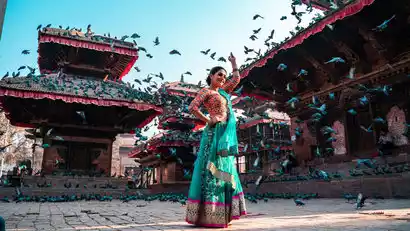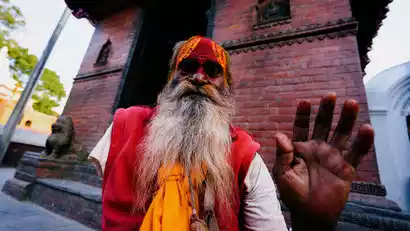Day 1 Kathmandu ★Meeting day
All day
Tourists from all over the world are attracted by the call of the snow-capped mountains and come to Nepal, a small country at the southern foot of the Himalayas. Upon arrival, you will be picked up at the airport (one registration fee, only available on the day of assembly). You will then check in at the assembly hotel in Kathmandu.
How to get there
There are many flights to Kathmandu (Tribhuvan International Airport, airport code KTM) where you can choose from. We recommend purchasing direct flights from all over the country to Kathmandu:
1. Direct flights to Kathmandu from many domestic cities (Chengdu, Beijing, Kunming, Guangzhou, etc.)
2. In addition, you can choose to connect. If you purchase a connecting flight, please note that there should be a certain amount of time between the two flights, usually more than 3 hours, to avoid being late and missing the flight.
丨Physical fitness & experience requirements
Age: 18-65
Physical fitness: Ability to hike 20 kilometers a day and climb more than 1,000 meters
Experience: Experience hiking at altitudes above 4,000 meters
Route reference: Gongga Grand Loop, Yading Grand Pilgrimage, Meili North Slope, Haba Snow Mountain, etc.


Day 2 Kathmandu → Lukla → Phakding (2610m)
All day
Flight time: about 30 minutes
Hiking distance: about 8KM
Hiking time: about 4 hours
Cumulative lift: +200M/-420M
Today we took an early morning flight from Kathmandu to Lukla (fare included). Through the clouds, we could vaguely see the villages, mountains, woods, and lakes below. We could also appreciate the panoramic view of the eastern Himalayas. It was so beautiful here that it was unforgettable!
Note: From March to May and October to December, there is only one flight per day between Kathmandu and Lukla. Tickets are very limited, so we recommend booking early. If you are unable to book a flight, you will need to take a bus from Kathmandu to Ramechhap Airport in the early morning for a flight, which takes approximately six hours. Tickets are limited, so we recommend booking early.
After arriving in Lukla (2,700 meters), we met up with our local Sherpa porters, packed our bags, and headed towards the Dodo Valley. We passed the village of Chaunrikarka (2,621 meters), crossed vegetable fields, crossed the Dodo River on a wooden bridge, and finally arrived at Phakding (2,600 meters). No matter how the scenery changed, the towering peaks seemed like giants, watching over our every step.


Day 3 Phakding → Monjo (2840m) → Namche Bazar (3440m)
All day
Hiking distance: about 10KM
Hiking time: about 8 hours
Cumulative lift: +1200M/-400M
Today's hike begins along the Dodo River. The path is gently sloping, with ascending and descending steps built by villagers. This day's acclimatization hike will see us crossing the Dodo River, passing through the village of Jorsale (2,805 meters), and then ascending the steep slope. Half an hour later, we'll see Mount Everest in the distance. This "Goddess" peak of the Himalayas, capped with snow and shrouded in mist, we'll see the "writings of the people of this snowy land on the roof of the world" along the Namche Trail. We'll then reach Sagarmatha National Park, where our team leader will sign the customs documents.
Our destination was Namche Bazar (3,440 meters), a famous commercial center in Nepal, where merchants from Tibet set up shop, selling jewelry and handicrafts brought from Tibet. After the arduous mountain hike, everything in this small town seemed peaceful and tranquil.


Day 4 Namche Bazar full day activities
All day
Full day excursion! Adaptation
In the early morning of Nanchi, when you open the door, the beautiful scenery around the hotel will hit you. If you are interested and energetic, you can get up early and take pictures of the sunrise over the Golden Mountain in the hotel!
Today we'll spend the day in this famous Sherpa village. This large town on the EBC route offers a place to restock supplies, exchange RMB for Nepalese currency, apply for a mobile phone SIM card, and enjoy the last hot shower on the EBC route. It's also the last place to charge your phone for free. The Sherpa Museum is also located here. Near Namche Bazar are three snow-capped peaks over 6,000 meters: from right to left: Kwangde Peak, Kangtega Peak (6,783 meters), and Thamserku Peak (6,604 meters).
There's a weekly market here, where nearby farmers bring their wheat, corn, and millet, hoping to sell them for a good price. We'll browse Tibetan handicraft shops, visit the market to see the local crops, and follow our guide to a local restaurant for lunch. We'll learn how to greet the locals with the Namaste gesture, expressing friendship and respect, and experiencing life at high altitude.


Day 5 Namche Bazar → Tyangboche (3840 meters)
All day
Hiking distance: about 10KM
Hiking time: about 7 hours
Cumulative lift: +1000M/-500M
After breakfast, we set off. The scenery along this stretch is particularly spectacular. On a clear day, you can see Mount Everest, Lhotse, and the Ama Dablam peaks. If you're lucky, you might even spot Nepal's national bird, the Emperor Pheasant, along the roadside. A 600-meter section of the hike follows a gently sloping path along the ridge, ultimately leading to a flat slope called Mong. The hike offered spectacular views of two peaks, and the ups and downs along the way strengthened our endurance and perseverance, while also helping our bodies adapt to the high-altitude environment.
The scenery of Tyangboche (3867 meters) is very beautiful. On a clear day, if you open the window of your room at the Himalaya Inn, you can see the huge 16:9 aspect ratio scenery!


Day 6: Tyangboche → Dingboche (4350 meters)
All day
Hiking distance: about 10KM
Hiking time: about 6 hours
Cumulative lift: +700M/-250M
Today is another day of heavy hiking.
We slowly ascended, realizing that every step forward was crucial. It was our perseverance that allowed us to experience even more spectacular scenery. Tengboche boasts one of the largest Tibetan Buddhist temples in the Khumbu region. The monks there speak Tibetan, and when we greet them with "Tashi Delek," they respond in a friendly manner. We then continued our gentle climb to Pangboche for lunch, the viewpoint of Ama Dablam. About two hours ahead, we reached the fork in the road to Dingboche and Periche.
As the altitude rises to 4,000 meters, altitude sickness may become more obvious. Our team leader will provide professional and caring help to lead us through the difficulties. We will stay in Dingboche (4,350 meters) at night.


Day 7 Dingboche → Luboche (4930 meters)
All day
Hiking distance: about 8KM
Hiking time: about 6 hours
Cumulative elevation: +580M
Compared to the previous few days, today's hike will be a little easier.
We first followed the trail to Thokla (4,620 meters), then continued along the valley, with the majestic peaks of Lhotse and Nuptse to our left and Ama Dablam, like an eagle spreading its wings, to our right, a truly breathtaking sight. We then ascended a steep climb to Thokla Pass, where a monument commemorates those who lost their lives climbing Mount Everest.
Mount Everest is a distant dream for every mountaineering enthusiast. Even if those ahead of us fall, those behind us will continue to move forward, carrying this shared dream with them. Therefore, everyone on this journey is worthy of respect. We arrived at Luboche (4,930 meters) for a rest stop.


Day 8 Luboche → Gorakshep → Kala Pattha (5630m) → Gorakshep (5180m)
All day
Hiking distance: about 8KM
Hiking time: about 6 hours
Cumulative lift: +720M/-480M
Today was the highlight of our trip! Waking up early allowed us to witness the stunning morning scenery of the high alpine region. From Chhukhung RI, just behind Chhukhung Village, we could see the massive mass of Lhotse face-to-face, surrounded by Ama Dablam, Island Peak, and Nuptse. The scenery was breathtaking, and it was one of the three most famous viewpoints along the entire trek.
We'll continue along the glaciers of the Khumbu region, reaching Gorakshep (5,180 meters). Then, we'll ascend a steep slope to the renowned Kala Patthar viewpoint, a focal point for many of Everest's southern slopes. From here, we'll witness a breathtaking sunset over Everest. Witnessing the breathtaking golden glow of the sun against this vast snowy backdrop—perhaps this is the true meaning of this journey. From Sagarmatha, we'll witness the most breathtaking views of Everest! We'll quietly gaze upon the breathtaking beauty of Everest, etching this scene in our minds forever.
After sunset we need to go down the mountain in the dark, so please bring headlamps and other lighting tools. After returning to Gorikshap, after laughter and joy, we fell asleep peacefully with the snow-capped mountains as our pillows.
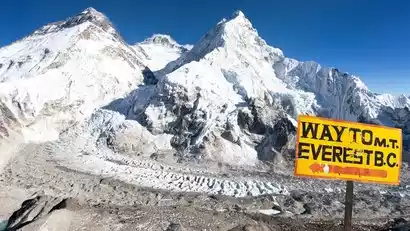
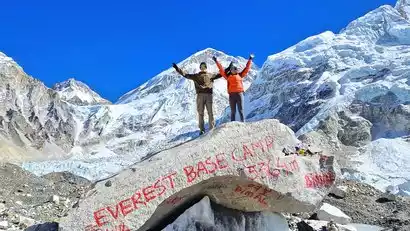
Day 9 Gorakshep → Everest Base Camp (5364m) → Luboche
All day
Hiking distance: about 12 km
Hiking time: about 7 hours
Cumulative lift: +190M/-420M
Today we finally arrived at the most anticipated place of this trip - Qomolangma. Everest Base Camp (5364 meters).
After breakfast, we set off and, after a short climb, finally reach Everest Base Camp. Nestled in the valley at the heart of the ridge, we are surrounded by renowned peaks like Everest (8,848 meters), Lhotse (8,516 meters), Nuptse (7,864 meters), and Pumori (7,185 meters), like giants guarding their shared treasures. We will briefly rest at Base Camp before preparing for our return journey.
Today is a tiring day. We will descend all the way from the base camp to Luboche (4930 meters). We will check into the inn and take a rest. You can enjoy the fragrant coffee by the fire while looking out the window at the snow-capped mountains.
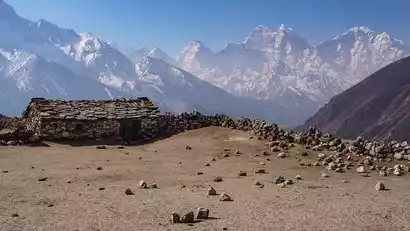
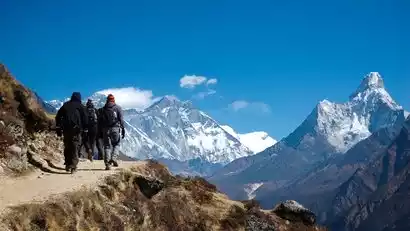
10th Luboche → Tengboche → Namche Bazar
All day
Hiking distance: about 24 km
Hiking time: about 10 hours
Cumulative lift: +750M/-2260M
As we descended the mountain, we looked back at the scenery we had passed, and felt a different mood. The hardships of the past were over, and a new and beautiful tomorrow was waiting for us. The scenery along this stretch was particularly spectacular. In the afternoon, we will return to [Namche Bazar (3340 meters)]
We will be leaving the mountains tomorrow. If you have any gear or clothes you no longer need after hiking, you can leave them for the porters. They are constantly in and out of the mountains, so their gear wears out a lot and their income is limited. It is important to note that porters work very hard. Foreign countries place great emphasis on tipping, and tips are an important source of income for porters. China-TravelNote has already paid for the corresponding portion, but hikers still need to pay a portion in person as a token of their appreciation for the porters' hard work. A reference tip of US$5 per person per day is recommended.
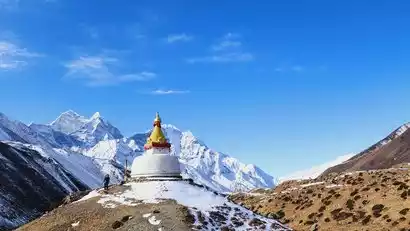
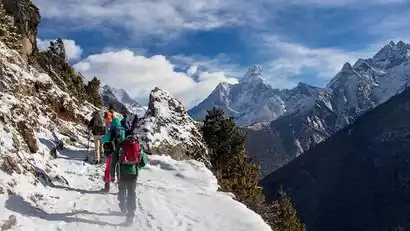
Day 11 Namche Bazar → Phakding → Lukla (2840 meters)
All day
Hiking distance: about 10KM
Hiking time: about 6 hours
Cumulative lift: +420M/-120M
Today we'll pass through Gumila Forest. If you time it right, from March to May, you'll be able to see a vibrant display of rhododendrons. Specifically, nine species of rhododendrons bloom along the trail, creating a breathtaking spectacle. The rhododendron is Nepal's national flower, and stumbling upon a vast expanse of rhododendrons during this season is truly a blessing.
Descending back to Lukla, we listened to the rustling of leaves in the wind, lost in the green of the forest and the blue of the sky. Looking back on the road we had taken, we couldn't help but feel a sense of emotion.
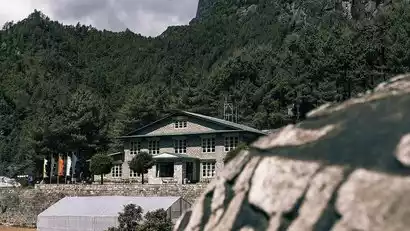
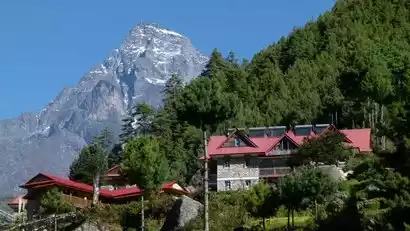
Day 12 Lukla → Kathmandu
All day
Flight time: about 30 minutes
We take a morning flight back to Kathmandu and if the weather is fine we can once again look down upon the beautiful Himalayas.
After arrival, you can freely explore the famous "Thamel" commercial district and enjoy shopping. Thamel Street is the center of Kathmandu. Tourists from all over the world, small hotels, bars, restaurants, shops, stalls, bookstores, travel agencies, etc. gather here. There are a wide variety of goods here, which is dazzling. The fun of shopping makes people excited. Nepalese handicrafts such as Buddha statues, thangkas, wool blankets, handicraft accessories, paper crafts, oil paintings, Gurkha sabers, wool shawls, South Asian style CDs, Nepalese style postcards, landscape paintings, Nepalese cotton clothing, Nepalese wood carvings, pottery, metal products, etc. are worth buying.
In the evening we will hold a celebration banquet to celebrate the successful completion of this not-so-easy journey, recalling every detail of the past few days, and from this moment on, we begin to miss the days in the mountains.
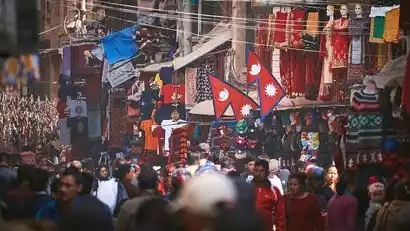
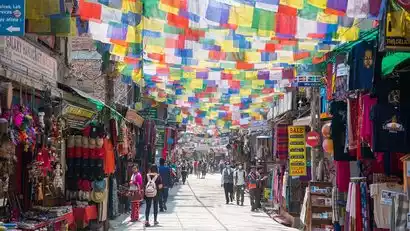
Day 13 Kathmandu★ Disbandment Day
All day
Tourists who are still reluctant to leave and bid farewell with tears, please remember to fill out a follow-up review on the "China-TravelNote APP" to win vouchers. You can also post travel notes or works of art on the "China-TravelNote Community" & "China-TravelNote Photography Network" to share the wonderful memories of your trip!
Please choose your return flight based on your needs. You can travel to the airport together. The journey from the city center takes approximately 30 minutes to an hour. Friendly reminder: For international flights, please arrive at the airport three hours in advance to check in.
Kind tips:
Due to the occasional delays in flights between Kathmandu and Lukla, and the unpredictability of outdoor activities, it is recommended to reserve one more day for the return trip! !
